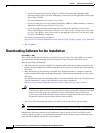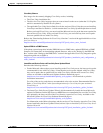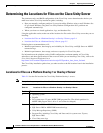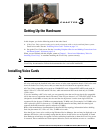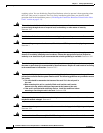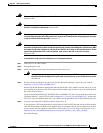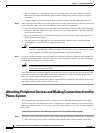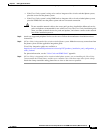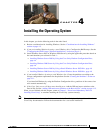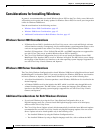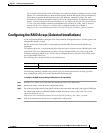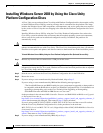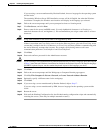
3-4
Installation Guide for Cisco Unity Release 5.x with IBM Lotus Domino (Without Failover)
OL-13599-01
Chapter 3 Setting Up the Hardware
Attaching Peripheral Devices and Making Connections from the Phone System
• If the slot location of a customer-provided server management card (such as Hewlett-Packard
Remote Insight Lights-Out Edition) conflicts with a required host card slot, the host card takes
precedence.
• Using an unapproved slot for the host card can cause a conflict with the RAID controller card.
Step 6 Insert each voice card firmly into its slot in the server or in the expansion chassis, and fasten each card
to the back plate with a screw. Note the following considerations, as applicable:
• If you are installing more than one voice card of the same model, and if the cards include a hardware
setting that indicates which card is first, second, and so on, install the cards in the order specified
by the hardware settings.
• If you are installing voice cards of different models in the same server, install cards of the same
model adjacent to one another.
• Choose a physically compatible slot in an appropriate bus segment. Refer to the manufacturer
documentation for detailed PCI bus topology information.
Caution Placing a 33-MHz Intel Dialogic voice card in a physical interface slot in the same logical
segment as a 66-MHz PCI or 100-to-133-MHz PCI-X interface card will slow both slots in the
logical segment to 33 MHz, degrading performance of the whole platform.
Step 7 If you are installing multiple voice cards that have H.100 bus connectors, cable the cards together. On
each card, connect the cable so the red stripe on the cable corresponds with pin 1 on the card connector.
Confirm that the connectors are firmly seated.
Caution If you do not cable cards together as required, the voice card software will not start, and
Cisco Unity will not answer calls.
If the cable has more connectors than the server has voice cards, use the first and last connectors, and
leave unused connectors in the middle of the cable. If the end of a cable is allowed to dangle loose, it
can act as a radio antenna and pick up noise from the bus.
If you are cabling three or more cards together, connect the first connector on the cable to the first card,
the second connector to the second card, and so on.
Attaching Peripheral Devices and Making Connections from the
Phone System
We recommend that you connect the Cisco Unity server to a dedicated uninterruptible power supply.
A Cisco Unity server purchased from Cisco is configured for a specific hardware setup. Do not add or
change any hardware on the server, except to add voice cards, memory, a tape drive, an external modem,
or a rail kit.
To Attach Peripheral Devices and to Make Connections from a Circuit-Switched Phone System
Step 1 Place the server in a dry, cool area that is free of dust. Note the following considerations, as applicable:
• If the Cisco Unity server will be connected to the network, place it near a network connection.



